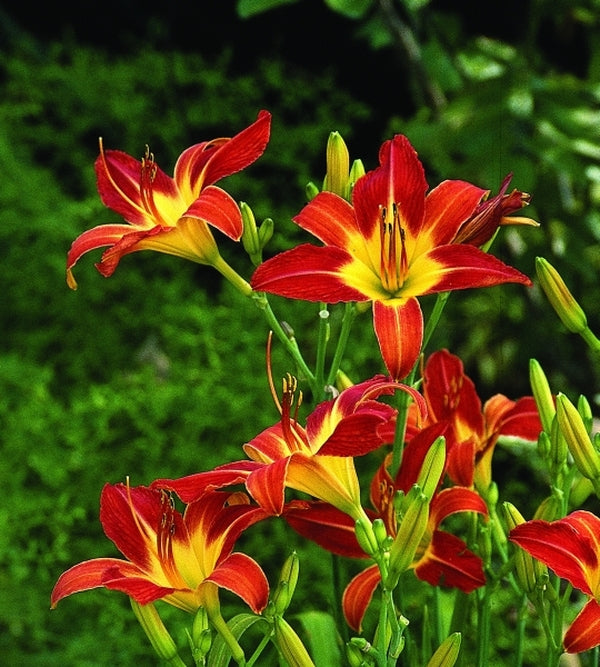Hemerocallis 'August Flame'
August Flame Daylily
Item #: 4323
Zones: 3a to 9b
Dormancy: Winter
Height: 40" tall
Origin: Hybrid
Pot Size: 3.5" pot (24 fl. oz/0.7 L)
(Woods 1967) In August, when most daylilies are just a memory, there are a few that stand alone...in full flower. One of our favorites is the '60s hybrid (you remember the '60s...free love, ban the bomb, get outta 'Nam), Hemerocallis 'August Flame'. From mid-July through August, the 3-4' tall flower stalks are topped with clusters of large, bright red flowers, each centered with a dramatic yellow-orange blotch...a hummingbird favorite. Because of its height and late season of flowering, Hemerocallis 'August Flame' is an excellent daylily for the perennial border.
Maintenance:
Hemerocallis, daylilies, are quite low maintenance; yet they benefit from a few properly timed tidying-ups that are simple and quickly accomplished. It helps to understand their normal life cycle: New daylily foliage is produced after winter gives way to spring. It is at this time quite clean and fresh and lovely. Yet it often becomes shabby by bloom time, it has worked so hard to produce all of its flowers. As the floral display is winding down the plant starts to put up a whole new flush of foliage. The flawless fresh new foliage might go unnoticed by the unobservant gardener but it is produced nevertheless. If at this point the whole plant is cut back hard, either to the ground or to several inches tall, not only will all of the spent flower stalks be removed but so too spring's now shabby foliage. What one is left with is clean foliage for the remainder of the growing season. And the process of cutting it back takes only a few minutes at most per plant.
Another time to cut daylily foliage down is after frost has killed the foliage. It has often been observed that this foliage will harbor aphids over winter if not removed. In mild-winter areas the daylilies described as evergreen might produce foliage during every mild spell. One needs to periodically check for aphids.
Growing Conditions:
Hemerocallis, Daylilies, are almost fool proof. They will thrive with full sun all day long yet still bloom most satisfactorily with fewer hours provided they have at least 6 hours of full sun. They tolerate a wide range of soil types and conditions including damp soil and briefly soggy soil. They will survive drive spells though they will not perform in chronically dry sites.
Garden Value:
The floral display of Hemerocallis is big and bold and bright. Individual cultivars are often in bloom for many weeks or even months. Cultivars are available from spring blooming ones to ones that bloom into late summer and even early fall. The peak bloom season is summer. Selecting cultivars that bloom at various times one can have daylilies in bloom for 5 to 6 months of the year.
Natural Impact:
Daylily flowers are occasionally visited by pollinators. The wild species of daylilies, some of which are the parents of the garden hybrids, are more likely to be utilized by pollinators.
Nomenclature:
The name Hemerocallis comes from the Greek hemera, “day" ) and kallos, “beauty" for though they produce a long succession of flowers, each individual flower lasts only one day.


-
Other Attributes
Genus: Hemerocallis
Flower Color: Multicolor , Red
Container Role: Thrillers
Garden Themes: Cottage Garden Plants , Living Wall
Other: Bog Garden Plants , Butterfly Attracting Plants , Edimentals , Cut Flower Plants , Drought Tolerant Plants , Hallucinogenic Plants , Hummingbird Plants , Pollinator Plants , Medicinal Plants , Plants that Attract Birds , Rabbit Resistant Plants , Rain Garden Plants , Salt Tolerant Seaside Plants



